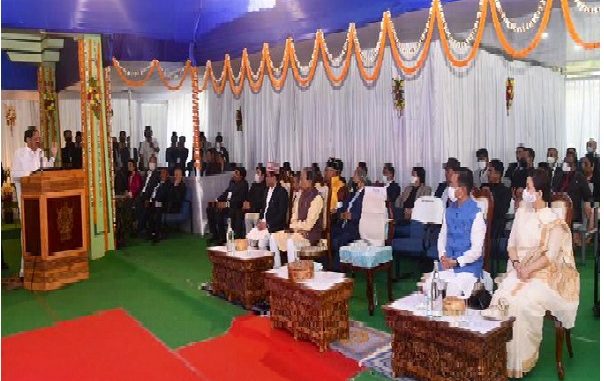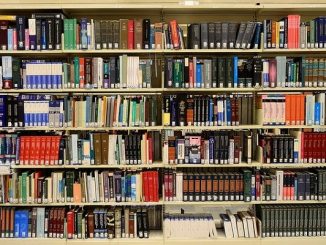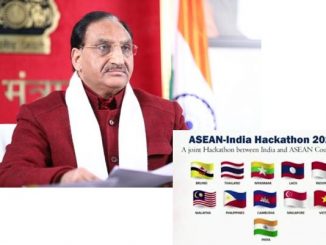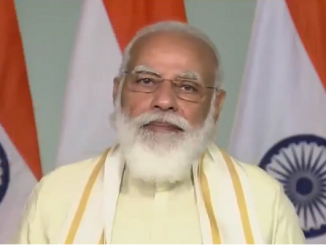
Mar 11: The Vice President, Shri M. Venkaiah Naidu today called upon universities to encourage scientific research in traditional knowledge systems such as organic farming and medicinal systems and ‘rediscover our intellectual capital’ in a systematic way.
Shri Naidu appreciated Sikkim, a leader in organic farming, for having started vocational training on the subject in all its secondary and senior secondary schools, apart from bringing out new primary textbooks with a focus on sustainable development.
The Vice President was laying the foundation stone virtually for the Khangchendzonga State University in Sikkim. Shri Naidu, who is on a four-day tour of Mizoram and Sikkim, arrived in Gangtok today.
Stressing on the important role of universities in fast-tracking all-around development, Shri Naidu observed that ‘with quality higher education, Sikkim can be a pacesetter in making education an important catalyst for sustainable development.
Shri Naidu said that universities in the region must develop linkages with the industry and local institutions to design innovative solutions to problems that are specific to the region. “In other words, think globally but act locally”, he said and urged students to take advantage of the region’s natural strengths in eco-tourism, horticulture, and handicrafts and strive for excellence.
Noting the impact of the COVID-19 pandemic on the education sector in India, Shri Naidu said that education cannot remain static and called for innovation and adaptation to the changing market demands.
Observing that the digital component of education would be a permanent feature, Shri Naidu called for democratizing technology to make learning opportunities more accessible and affordable for rural students. He also called upon central and state governments to give a boost to the development of quality digital content in local and regional languages.
Observing that the pandemic has highlighted the importance of physical education, Shri Naidu advised educators and parents to ensure the participation of students in regular physical activities. He added that students must be encouraged to spend some time in the lap of nature.
The Vice President also suggested that ‘academic curricula must be constantly updated and upgraded and students must be upskilled to face the new challenges and changing market demands. Calling for flexibility and dynamism in courses, ‘innovation should be the watchword, going forward, especially for higher education, he stressed.
Lauding Sikkim’s efforts in higher education, Shri Naidu noted that the state has the highest Gross Enrolment Ratio (GER) in Higher Education at 75.8%. He also appreciated the setting up of the Sikkim Education Reforms Commission (SERC) headed by the Chief Minister to ensure sincere implementation of NEP, 2020. “I compliment the state government for its proactive role in shaping Sikkim as the educational hub in the North East”, he said.
Later in the day, the Vice President briefly interacted with a group of students from Sikkim who were recently evacuated from Ukraine. He expressed happiness that the students, who were stranded in the conflict zone, could reach Sikkim safely with the active coordination between the Government of India and the State government.
Later, Shri Naidu unveiled a statue of Netaji Subhash Chandra Bose at Raj Bhawan, Sikkim in the presence of various officials and dignitaries. Shri Naidu also witnessed performances of folk songs and dances of Sikkim at a cultural event hosted by the Governor of Sikkim.
Governor of Sikkim, Shri Ganga Prasad, Chief Minister of Sikkim, Shri Prem Singh Tamang, Minister, Government of Sikkim, Shri K. N. Lepcha, Minister, Government of Sikkim, Shri B. S. Panth, public representatives, students, professors, and other dignitaries participated in the foundation laying ceremony of the KSU.
Following is the full text of the speech:
“Sisters and brothers,
I am very pleased to lay the foundation stone of the Kangchenjunga State University (KSU) today. This is the first-ever University of the State Government and I am sure that this institution will set new benchmarks and become an exemplar in imparting quality education.
As you all are aware, universities and other higher education institutions play a critical role in nation-building and taking India to greater heights in the education sector. In laying the foundation stone today for this state university, we are collectively laying the foundation for a more prosperous, developed Sikkim where learning becomes a key lever for sustainable progress.
I am happy to note that as per the latest All India Survey of Higher Education (AISHE) report, the Gross Enrolment Ratio (GER) of Sikkim state in Higher Education stands at 75.8% which is the highest in India. Another noteworthy development is that the government of Sikkim has constituted the Sikkim Education Reforms Commission (SERC) to ensure sincere implementation of NEP, 2020 headed by the Chief Minister. These are commendable measures and I compliment the state government for its pro-active role in shaping Sikkim as the educational hub in the North East.
Sisters and brothers,
The National Education Policy (NEP), 2020 is a visionary document that seeks to strengthen the education sector as a whole. It seeks to bring in the much-needed reforms in both school and higher education in tune with the demands of the 21st century. The NEP 2020 lays special emphasis on pre-primary and primary education, vocational education, improving the quality of teaching, teachers’ training, creative use of technology, flexibility, and excellence in higher education. A sound policy is only the first step. What is critical is how well the NEP gets implemented in our educational institutes.
The states have to implement NEP-2020 with missionary zeal to bring about transformation in the learning-teaching ecosystem and achieve the desired outcomes. I am happy to learn that Sikkim has already initiated a number of steps for effective implementation of the provisions of the NEP and the setting up of permanent campus of KSU shall be another step in that direction.
Sisters and brothers,
I am particularly pleased to inaugurate this State University because education is potentially one of the most effective tools to fast-track all round development in the North-Eastern region.
For the youth of this region, universities such as this create enormous opportunities to expand their knowledge and acquire new skill sets required for the 21st century. On their part, youth must take full advantage of the opportunities provided to them and strive for excellence in their chosen domains. This region has natural strengths in areas such as eco-tourism, horticulture, and handicrafts. They need to be given a special thrust. By leveraging the talent of this region’s young and enterprising population, we need to build sustainable business models that will ultimately benefit the people of the state.
Universities like this must collaborate with some of the reputed academic institutions within India as well as other parts of the world to promote cutting-edge research. While largely focusing on academic activities, universities must develop linkages with the industry and local institutions to design innovative solutions to problems that are specific to the region. In other words, think globally but act locally.
Lastly, universities must encourage research into the traditional knowledge systems, for instance, organic farming and the medicinal system – Sowa Rigpa in the case of Sikkim. The idea should be to rediscover our intellectual capital and systematically and scientifically build on the knowledge base inherited collectively.
In this regard, it is heartening to know that Sikkim, which is a leader in organic farming, has started vocational training on the subject in all its Secondary and Senior Secondary schools. I am told that Sikkim has also brought out new primary textbooks with a focus on sustainable development. With quality research facilities being developed in the Higher Education sector, Sikkim is a pacesetter in making education an important catalyst for sustainable development.
I am also happy to learn that the state government is setting up a University of Excellence at Chakung, West Sikkim, and dedicating it to Netaji Subhash Chandra Bose. The this University of Excellence shall create a knowledge repository about flora and fauna, people, their culture and heritage, apart from the environment and climate change of this part of the country with a special focus on Eastern Himalayas. This will keep the ancient heritage of Sikkim alive and thriving for many generations to come. It is indeed a great and fitting tribute to Netaji in the 75th year of Independence, when the entire country is celebrating Azadi ka Amrit Mahotsav.
Sisters and Brothers,
The COVID-19 pandemic created a huge upheaval for the education sector when schools and colleges had to be closed for a very long period, abruptly forcing education to go completely online. Sikkim state, which has a difficult terrain and poor network connectivity, had to face multiple challenges in switching to online education. However, I am happy to note that the state has conducted online classes to bridge the learning deficit and also started homeschooling. I am also told the State also launched a dedicated App for its senior students and has imparted training for its teachers virtually. These are truly commendable efforts.
Now, with more than 180 crore vaccine doses administered and COVID-19 cases in the country tapering off, many educational institutions are opening up for students to attend classes physically.
As we transition back to our classrooms- through a variety of hybrid modes, it is important to reflect on our existing systems. We must try to understand the structural weaknesses that have become evident during the pandemic and bring out innovative solutions.
For instance, the digital component of education is here to stay. We must democratize the technology needed for this – cheaper electronic devices, faster internet connectivity, and open-source digital portals, thereby making learning opportunities more accessible and affordable for rural students. Digital content in Indian languages is also at a nascent stage. Central and state governments must give a boost to the development of quality digital content in local and regional languages.
Similarly, the pandemic has also highlighted the importance of a key aspect of education- that of physical education. Experts have suggested that confinement of students to homes during the last year without any physical activity or social interaction has had an impact on their mental and emotional well-being. As we move back to offline classrooms, educators and parents must ensure that students have adequate physical activities. Students must be encouraged to spend some time in the lap of nature. We must implement this key takeaway from the experience of education during the pandemic.
The pandemic has also taught us the importance of adapting to sudden and unexpected situations. This must reflect in our education system, which cannot remain static. We should constantly update and upgrade our curricula and upskill our students to face new challenges. Students must be kept abreast of the latest technological developments, new job roles, and changing market demands. Courses too, should be dynamic and allow for flexibility. Innovation should be the watchword, going forward, especially for higher education.
Sisters and brothers,
Sikkim is clearly putting in inspired efforts in education and I wish it all the success in the years to come. It is my sincere desire to see at least 10 universities from the North Eastern region in the top 100 institutions in the NIRF (National Institutional Ranking Framework) of the country. I believe this is possible in the near future and my best wishes to Sikkim to lead the way.
Once again, I am very happy to have laid the foundation stone for this University. My best wishes to the University for its future endeavors.
Namaskar. Jai Hind!”
Disclaimer: We donot claim that the images used as part of the news published are always owned by us. From time to time, we use images sourced as part of news or any related images or representations. Kindly take a look at our image usage policy on how we select the image that are used as part of the news.


